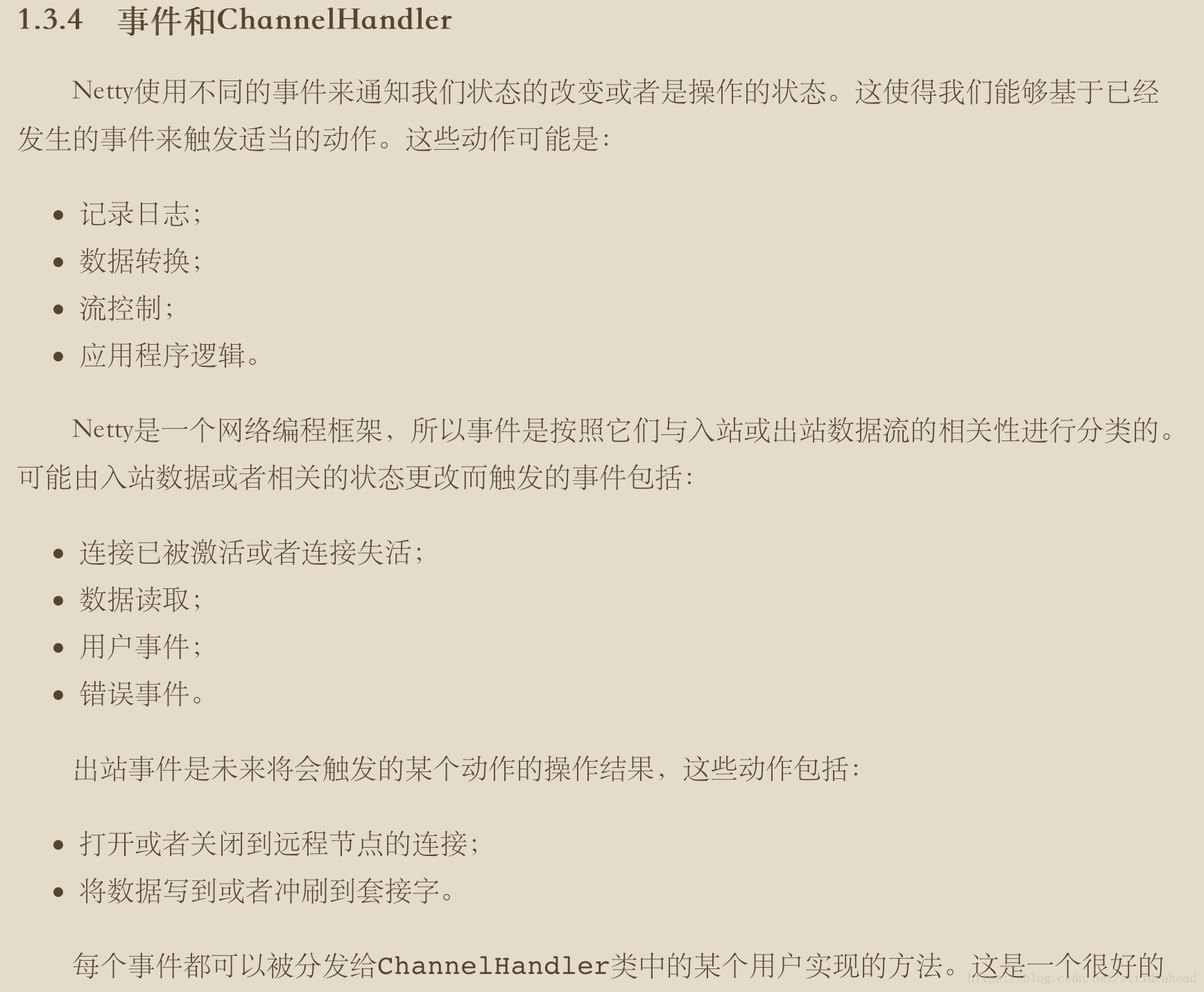netty的核心组件
Channel、回调、Future、事件和ChannelHandler,这些构建块代表了不同类型的构造:资源逻辑以及通知,你的应用程序将使用它来访问网络以及流经网络的数据。
Channel 是java NIO的一个基本构造,代表一个到实体的开放连接,如读操作和写操作,传入和传出数据的载体。
回调:netty在内部使用了回调来处理事件,当一个回调被触发时,相关的事件可以被一个interface-ChannelHandler的事件来处理
Future 提供了另一种在操作完成时通知应用程序的方式,

import io.netty.bootstrap.ServerBootstrap;
import io.netty.channel.ChannelFuture;
import io.netty.channel.ChannelInitializer;
import io.netty.channel.EventLoopGroup;
import io.netty.channel.nio.NioEventLoopGroup;
import io.netty.channel.socket.SocketChannel;
import io.netty.channel.socket.nio.NioServerSocketChannel;
import java.net.InetSocketAddress;
/**
* 代码清单 2-2 EchoServer 类
*
* @author <a href="mailto:norman.maurer@gmail.com">Norman Maurer</a>
*/
public class EchoServer {
private final int port;
public EchoServer(int port) {
this.port = port;
}
public static void main(String[] args)
throws Exception {
if (args.length != 1) {
System.err.println("Usage: " + EchoServer.class.getSimpleName() +
" <port>"
);
return;
}
//设置端口值(如果端口参数的格式不正确,则抛出一个NumberFormatException)
int port = Integer.parseInt(args[0]);
//调用服务器的 start()方法
new EchoServer(port).start();
}
public void start() throws Exception {
final EchoServerHandler serverHandler = new EchoServerHandler();
//(1) 创建EventLoopGroup
EventLoopGroup group = new NioEventLoopGroup();
try {
//(2) 创建ServerBootstrap
ServerBootstrap b = new ServerBootstrap();
b.group(group)
//(3) 指定所使用的 NIO 传输 Channel
.channel(NioServerSocketChannel.class)
//(4) 使用指定的端口设置套接字地址
.localAddress(new InetSocketAddress(port))
//(5) 添加一个EchoServerHandler到于Channel的 ChannelPipeline
.childHandler(new ChannelInitializer<SocketChannel>() {
@Override
public void initChannel(SocketChannel ch) throws Exception {
//EchoServerHandler 被标注为@Shareable,所以我们可以总是使用同样的实例
//这里对于所有的客户端连接来说,都会使用同一个 EchoServerHandler,因为其被标注为@Sharable,
//这将在后面的章节中讲到。
ch.pipeline().addLast(serverHandler);
}
});
//(6) 异步地绑定服务器;调用 sync()方法阻塞等待直到绑定完成
ChannelFuture f = b.bind().sync();
System.out.println(EchoServer.class.getName() +
" started and listening for connections on " + f.channel().localAddress());
//(7) 获取 Channel 的CloseFuture,并且阻塞当前线程直到它完成
f.channel().closeFuture().sync();
} finally {
//(8) 关闭 EventLoopGroup,释放所有的资源
group.shutdownGracefully().sync();
}
}
}
因为你的Echo服务器会响应传入的消息,所以需要实现ChannelInboundHandler接口,用来定义响应入站事件的方法。
继承
Channel- InboundHandlerAdapter类就够了,
@Sharable
public class EchoServerHandler extends ChannelInboundHandlerAdapter {
@Override
public void channelRead(ChannelHandlerContext ctx, Object msg) {
ByteBuf in = (ByteBuf) msg;
//将消息记录到控制台
System.out.println(
"Server received: " + in.toString(CharsetUtil.UTF_8));
//将接收到的消息写给发送者,而不冲刷出站消息
ctx.write(in.toString(CharsetUtil.UTF_8)+", hello world");
}
@Override
public void channelReadComplete(ChannelHandlerContext ctx)
throws Exception {
//将未决消息冲刷到远程节点,并且关闭该 Channel
ctx.writeAndFlush(Unpooled.EMPTY_BUFFER)
.addListener(ChannelFutureListener.CLOSE);
}
@Override
public void exceptionCaught(ChannelHandlerContext ctx,
Throwable cause) {
//打印异常栈跟踪
cause.printStackTrace();
//关闭该Channel
ctx.close();
}
}
了解Netty对于关注点分离的架构原则的支持。通过提供正确的抽象来解耦业务逻辑和网络编程逻辑,Netty使得可以很容易地跟上快速演化的需求,而又不危及系统的稳定性。






 本文介绍了Netty的核心组件,包括Channel、回调、Future等,并通过一个EchoServer示例展示了如何使用这些组件。Netty通过关注点分离的原则,使得业务逻辑与网络编程逻辑解耦,易于应对需求变化。
本文介绍了Netty的核心组件,包括Channel、回调、Future等,并通过一个EchoServer示例展示了如何使用这些组件。Netty通过关注点分离的原则,使得业务逻辑与网络编程逻辑解耦,易于应对需求变化。
















 668
668

 被折叠的 条评论
为什么被折叠?
被折叠的 条评论
为什么被折叠?








